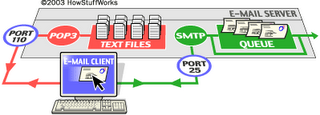How E-MAIL works ??
The Real E-mail System
 real e-mail system consists of two different servers running on a server machine. One is called the SMTP server, where SMTP stands for Simple Mail Transfer Protocol. The SMTP server handles outgoing mail. The other is either a POP3 server or an IMAP server, both of which handle incoming mail. POP stands for Post Office Protocol, and IMAP stands for Internet Mail Access Protocol.
real e-mail system consists of two different servers running on a server machine. One is called the SMTP server, where SMTP stands for Simple Mail Transfer Protocol. The SMTP server handles outgoing mail. The other is either a POP3 server or an IMAP server, both of which handle incoming mail. POP stands for Post Office Protocol, and IMAP stands for Internet Mail Access Protocol. A typical e-mail server looks like this:
An E-mail MessageThe first e-mail message was sent in 1971 by an engineer named Ray Tomlinson. Prior to this, you could only send messages to users on a single machine. Tomlinson's breakthrough was the ability to send messages to other machines on the Internet, using the @ sign to designate the receiving machine.
An e-mail message has always been nothing more than a simple text message -- a piece of text sent to a recipient. In the beginning and even today, e-mail messages tend to be short pieces of text, although the ability to add attachments now makes many e-mail messages quite long. Even with attachments, however, e-mail messages continue to be text messages -- we'll see why when we get to the section on attachments
E-mail Clients
You have probably already received several e-mail messages today. To look at them, you use some sort of e-mail client. Many people use well-known stand-alone clients like Microsoft Outlook, Outlook Express, Eudora or Pegasus. People who subscribe to free e-mail services like Hotmail or Yahoo use an e-mail client that appears in a Web Page. If you are an AOL customer, you use AOL's e-mail reader. No matter which type of client you are using, it generally does four things:
1. It shows you a list of all of the messages in your mailbox by displaying the message headers. The header shows you who sent the mail, the subject of the mail and may also show the time and date of the message and the message size.
2. It lets you select a message header and read the body of the e-mail message.
3. It lets you create new messages and send them. You type in the e-mail address of the recipient and the subject for the message, and then type the body of the message.
4. Most e-mail clients also let you add attachments to messages you send and save the attachments from messages you receive.
Sophisticated e-mail clients may have all sorts of bells and whistles, but at the core, this is all that an e-mail
client does.
A Simple E-mail Server:
Given that you have an e-mail client on your machine, you are ready to send and receive e-mail. All that you need is an e-mail server for the client to connect to. Let's imagine what the simplest possible e-mail server would look like in order to get a basic understanding of the process. Then we will look at the real thing.
You know that machines on the Internet can run software applications that act as servers. There are Web servers, FTP servers, telnet servers and e-mail servers running on millions of machines on the Internet right now. These applications run all the time on the server machine and they listen to specific ports, waiting for people or programs to attach to the port . The simplest possible e-mail server would work something like this:
1. It would have a list of e-mail accounts, with one account for each person who can receive e-mail on the server. My account name might be mbrain, John Smith's might be jsmith, and so on.
2. It would have a text file for each account in the list. So the server would have a text file in its directory named MBRAIN.TXT, another named JSMITH.TXT, and so on.
3. If someone wanted to send me a message, the person would compose a text message ("Marshall, Can we have lunch Monday? John") in an e-mail client, and indicate that the message should go to mbrain. When the person presses the Send button, the e-mail client would connect to the e-mail server and pass to the server the name of the recipient (mbrain), the name of the sender (jsmith) and the body of the message.
4. The server would format those pieces of information and append them to the bottom of the MBRAIN.TXT file.
There are several other pieces of information that the server might save into the file, like the time and date of receipt and a subject line; but overall, you can see that this is an extremely simple process.
As other people sent mail to mbrain, the server would simply append those messages to the bottom of the file in the order that they arrived. The text file would accumulate a series of five or 10 messages, and eventually I would log in to read them. When I wanted to look at my e-mail, my e-mail client would connect to the server machine. In the simplest possible system, it would:
1. Ask the server to send a copy of the MBRAIN.TXT file
2 . Ask the server to erase and reset the MBRAIN.TXT file
3. Save the MBRAIN.TXT file on my local machine
4. Parse the file into the separate messages (using the word "From:" as the separator)
5. Show me all of the message headers in a list

0 Comments:
Post a Comment
<< Home